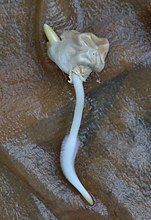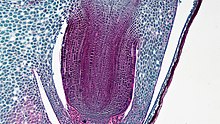Coleorhiza
The coleorhiza or root sheath is a protective layer of tissue that surrounds the radicle (the embryonic primary root) in monocotyledon seeds.[1] During germination, the coleorhiza is the first part to grow out of the seed, growing through cell elongation. Soon afterwards, it is pierced through by the emerging primary root and then remains like a collar around the root base. Also the adventitious roots have a coleorhiza.
- Coleorhiza with sweet corn
- Collar of the coleorhiza and coleoptile with sweetcorn
- Grain of wheat. co = coleorhiza, r1 and r2 = root
- Corn grain length section, A=Pericarp, B=Aleurone, C=Tip cap, D=Endosperm, E=Coleorhiza, F=Radicle, G=Hypocotyl, H=Plumule, I=Scutellum, J=Coleoptile. Scale=1.4mm.
- Root of corn with rootcap and coleorhiza
References
- ^ Barrero, José M.; Talbot, Mark J.; White, Rosemary G.; Jacobsen, John V.; Gubler, Frank (June 2009). "Anatomical and Transcriptomic Studies of the Coleorhiza Reveal the Importance of This Tissue in Regulating Dormancy in Barley". Plant Physiology. 150 (2): 1006–1021. doi:10.1104/pp.109.137901. PMC 2689963. PMID 19386806.
External links
- Difference between coleoptile and coleorhiza
Definition of coleoptile : The plumule are enclosed in sheaths which are called coleoptile. They protect the plumule for future, as in future it develops into shoot.





